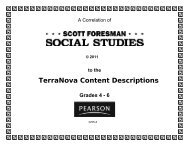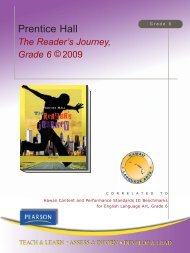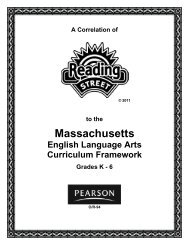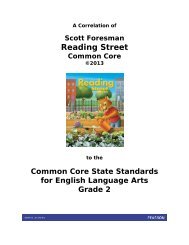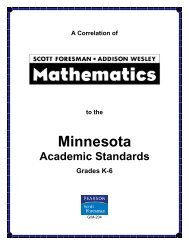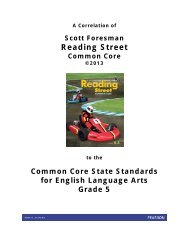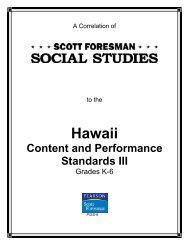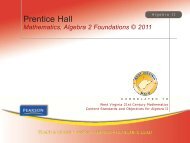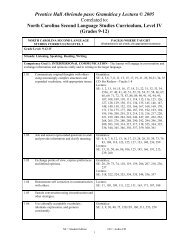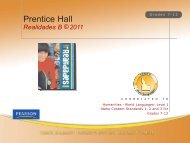Connected Mathematics 2, 7th Grade Units - Pearson
Connected Mathematics 2, 7th Grade Units - Pearson
Connected Mathematics 2, 7th Grade Units - Pearson
Create successful ePaper yourself
Turn your PDF publications into a flip-book with our unique Google optimized e-Paper software.
Prentice Hall <strong>Connected</strong> <strong>Mathematics</strong> 2, <strong>7th</strong> <strong>Grade</strong> <strong>Units</strong> © 2009Correlated to:Kentucky Core Content for <strong>Mathematics</strong> Assessment v. 4.1(<strong>Grade</strong>s 7)KENTUCKY CORE CONTENT FORASSESSMENT V. 4.1PAGE(S) WHERE TAUGHT(If submission is not a text, citeappropriate resource(s))Number Properties and OperationsMiddle grades students understand fractions, decimals, percents and integers, compare them andlocate their relative positions on a number line. They develop and use proportional reasoning tosolve Investigations. They work with large numbers and small numbers. They use factors, multiplesand prime factorizations. They perform arithmetic operations with fractions, decimals and integers,use properties in computation, develop fluency and develop strategies to estimate the result ofoperations on rational numbers.7 th <strong>Grade</strong>Number SenseMA-07-1.1.1Students will provide examples of andidentify integers, fractions, decimals,percents and π.DOK 1MA-07-1.1.2Students will describe and provide examples ofrepresentations of numbers (whole numbers,fractions, decimals, percents, integers, squareroots, and π) and operations in a variety ofequivalent forms using models, diagrams, andsymbols (e.g., number lines, 10 by 10 grids,rectangular arrays, number sentences), basedon real-world and mathematical Investigations.SE: Variables and Patterns Investigation 2:Analyzing Graphs and Tables (44); Stretchingand Shrinking Investigation 1: Enlarging andReducing Shapes (15); Accentuate theNegative Investigation 1: Extending theNumber System (5–15); Filling and WrappingInvestigation 3: Prisms and Cylinders (43)TG: Variables and Patterns Investigation 2:Analyzing Graphs and Tables (65); Stretchingand Shrinking Investigation 1: Enlarging andReducing Shapes (30); Accentuate theNegative Investigation 1: Extending theNumber System (15–32); Filling andWrapping Investigation 3: Prisms and Cylinders(75)SE: Variables and Patterns Investigation 2:Analyzing Graphs and Tables (44); Stretchingand Shrinking Investigation 2: Similar Figures(34–35), Investigation 3: Similar Polygons (56);Comparing and Scaling Investigation 2:Comparing Ratios, Percents, and Fractions (27);Accentuate the Negative Investigation 1:Extending the Number System (5–15),Investigation 2: Adding and Subtracting Integers(22–30, 40), Investigation 3: IntroducingMultiplication of Integers (44–45, 55),Investigation 4: Properties of Operations (64–67, 72–73); What Do You Expect?Investigation 1: Evaluating Games of Chance(14–15)2SE = Student Edition – TG = Teacher’s Guide
Prentice Hall <strong>Connected</strong> <strong>Mathematics</strong> 2, <strong>7th</strong> <strong>Grade</strong> <strong>Units</strong> © 2009Correlated to:Kentucky Core Content for <strong>Mathematics</strong> Assessment v. 4.1(<strong>Grade</strong>s 7)KENTUCKY CORE CONTENT FORASSESSMENT V. 4.1MA-07-1.1.3Students will convert among wholenumbers, fractions, decimals, percents andπ, and will compare and these numbers.DOK 2EstimationMA-07-1.2.1Students will estimate to solve real-worldand mathematical Investigations withfractions, decimals and percents, checkingfor reasonable and appropriatecomputational results.DOK 2PAGE(S) WHERE TAUGHT(If submission is not a text, citeappropriate resource(s))TG: Variables and Patterns Investigation 2:Analyzing Graphs and Tables (65); Stretchingand Shrinking Investigation 2: Similar Figures(52), Investigation 3: Similar Polygons (72);Comparing and Scaling Investigation 2:Comparing Ratios, Percents, and Fractions (48);Accentuate the Negative Investigation 1:Extending the Number System (15–32),Investigation 2: Adding and Subtracting Integers(37–52, 61), Investigation 3: Multiplying andDividing Integers (63–68, 83), Investigation 4:Properties of Operations (91–98, 100–101);What Do You Expect? Investigation 1:Evaluating Games of Chance (34)SE: Variables and Patterns Investigation 1:Variables, Tables, and Coordinate Graphs (23);Stretching and Shrinking Investigation 3:Similar Polygons (51), Investigation 5: UsingSimilar Triangles and Rectangles (85–86);Comparing and Scaling Investigation 1:Making Comparisons (6–9, 13–15), Investigation2: Comparing Ratios, Percents, and Fractions(18–23); Accentuate the NegativeInvestigation 2: Adding and Subtracting Integers(24–27); What Do You Expect? Investigation3: Expected Value (43)TG: Variables and Patterns Investigation 1:Variables, Tables, and Coordinate Graphs (40);Stretching and Shrinking Investigation 3:Similar Polygons (70), Investigation 5: UsingSimilar Triangles and Rectangles (103);Comparing and Scaling Investigation 1:Making Comparisons (19–26, 28–29),Investigation 2: Comparing Ratios, Percents,and Fractions (32–46); Accentuate theNegative Investigation 2: Adding andSubtracting Integers (41–44); What Do YouExpect? Investigation 3 Expected Value (73)SE: Variables and Patterns Investigation 3:Rules and Equations (55); Stretching andShrinking Investigation 1: Enlarging andReducing Shapes (6–7); Comparing andScaling Investigation 4: Making Sense ofProportions (57); Filling and WrappingInvestigation 3: Prisms and Cylinders (43);Data Distributions Investigation 2: MakingSense of Measures of Center (69)3SE = Student Edition – TG = Teacher’s Guide
Prentice Hall <strong>Connected</strong> <strong>Mathematics</strong> 2, <strong>7th</strong> <strong>Grade</strong> <strong>Units</strong> © 2009Correlated to:Kentucky Core Content for <strong>Mathematics</strong> Assessment v. 4.1(<strong>Grade</strong>s 7)KENTUCKY CORE CONTENT FORASSESSMENT V. 4.1Number OperationsMA-07-1.3.1Students will add, subtract, multiply anddivide whole numbers, fractions anddecimals to solve real-world Investigationsand apply order of operations (includingpositive whole number exponents) tosimplify numerical expressions.DOK 2MA-07-1.3.2Students will explain how operations (additionand subtraction; multiplication and division) areinversely related.MA-07-1.3.3Students will add and subtract integers.PAGE(S) WHERE TAUGHT(If submission is not a text, citeappropriate resource(s))TG: Variables and Patterns Investigation 2:Rules and Equations (81); Stretching andShrinking Investigation 1: Enlarging andReducing Shapes (15–18); Comparing andScaling Investigation 4: Making Sense ofProportions (90); Filling and WrappingInvestigation 3: Prisms and Cylinders (75);Data Distributions Investigation 2: MakingSense of Measures of Center (28–43)SE: Comparing and Scaling Investigation 3:Comparing and Scaling Rates (34); Accentuatethe Negative Investigation 3: Multiplying andDividing Integers (55), Investigation 4: Order ofOperations (60–63, 66–67, 70); Filling andWrapping Investigation 3: Prisms and Cylinders(37), Investigation 5: Scaling Boxes (64–66)TG: Comparing and Scaling Investigation 3:Comparing and Scaling Rates (52–56);Accentuate the Negative (6), Investigation 3:Multiplying and Dividing Integers (84),Investigation 4: Order of Operations (87–90,95–98, 100); Filling and WrappingInvestigation 3: Prisms and Cylinders (69–72),Investigation 5: Scaling Boxes (101–108)SE: Accentuate the Negative Investigation 1:Extending the Number System (20),Investigation 2: Adding and Subtracting Integers(28–29), Investigation 3: Multiplying andDividing Integers (47–48), Investigation 4:Properties of Operations (71)TG: Accentuate the Negative Investigation 1:Extending the Number System (35),Investigation 2: Adding and Subtracting Integers(45–48), Investigation 3: Multiplying andDividing Integers (73–76), Investigation 4:Properties of Operations (100)SE: Accentuate the Negative Investigation 1:Extending the Number System (5–15, 19),Investigation 2: Adding and Subtracting Integers(22–30), Investigation 3: Multiplying andDividing Integers (55), Investigation 4: Order ofOperations (60–63)TG: Accentuate the Negative (3–6),Investigation 1: Extending the Number System(15–32, 34), Investigation 2: Adding andSubtracting Integers (37–52), Investigation 3:Multiplying and Dividing Integers (84),Investigation 4: Order of Operations (87–90)4SE = Student Edition – TG = Teacher’s Guide
Prentice Hall <strong>Connected</strong> <strong>Mathematics</strong> 2, <strong>7th</strong> <strong>Grade</strong> <strong>Units</strong> © 2009Correlated to:Kentucky Core Content for <strong>Mathematics</strong> Assessment v. 4.1(<strong>Grade</strong>s 7)KENTUCKY CORE CONTENT FORASSESSMENT V. 4.1Ratios and Proportional ReasoningMA-07-1.4.1Students will apply ratios and proportionalreasoning to solve real-worldInvestigations (e.g., percents, sales tax,discounts, rate).DOK 3Properties of Numbers and OperationsMA-07-1.5.1Students will identify and apply primenumbers, composite numbers, primefactorization, factors, multiples anddivisibility to solve real-world andmathematical Investigations (e.g., primefactorization to determine a least commonmultiple [LCM] or greatest common factor[GCF]).DOK 2PAGE(S) WHERE TAUGHT(If submission is not a text, citeappropriate resource(s))SE: Stretching and Shrinking Investigation 1:Enlarging and Reducing Shapes (12, 15–17),Investigation 4: Similarity and Ratios (60–65);Comparing and Scaling Investigation 1:Making Comparisons (5–9), Investigation 2:Comparing Ratios, Percents, and Fractions (18–23), Investigation 3: Comparing and ScalingRates (34–38), Investigation 4: Making Sense ofProportions (49–54); Accentuate the NegativeInvestigation 4: Properties of Operations (66–67); Data Distributions Investigation 1:Making Sense of Variability (5–11), Investigation3: Comparing Distributions: Equal Numbers ofData Values (55–59), Investigation 4:Comparing Distributions: Unequal Numbers ofData Values (74–77)TG: Stretching and Shrinking (6),Investigation 1: Enlarging and Reducing Shapes(29–30), Investigation 4: Similarity and Ratios(75–86); Comparing and Scaling (5–7),Investigation 1: Making Comparisons 15–26),Investigation 2: Comparing Ratios, Percents,and Fractions (32–46), Investigation 3:Comparing and Scaling Rates (52–68),Investigation 4: Making Sense of Proportions(74–88); Accentuate the NegativeInvestigation 4: Properties of Operations (95–98); Data Distributions Investigation 1:Making Sense of Variability (20–28),Investigation 3: Comparing Distributions: EqualNumbers of Data Values (74–82), Investigation4: Comparing Distributions: Unequal Numbers ofData Values (99–114)SE: Accentuate the Negative Investigation 3:Multiplying and Dividing Integers (48–49);Filling and Wrapping Investigation 2:Designing Rectangular Boxes (19–21)TG: Accentuate the Negative Investigation 3:Multiplying and Dividing Integers (63–68);Filling and Wrapping Investigation 2:Designing Rectangular Boxes (37–46)5SE = Student Edition – TG = Teacher’s Guide
Prentice Hall <strong>Connected</strong> <strong>Mathematics</strong> 2, <strong>7th</strong> <strong>Grade</strong> <strong>Units</strong> © 2009Correlated to:Kentucky Core Content for <strong>Mathematics</strong> Assessment v. 4.1(<strong>Grade</strong>s 7)KENTUCKY CORE CONTENT FORASSESSMENT V. 4.1MA-07-2.1.2Students will estimate measurements of regularand irregular polygons and circles in standardunits.MA-07-2.1.3Students will explain how measurements andmeasurement formulas are related or different(e.g., perimeter and area of rectangles).MA-07-2.1.4Students will find the measures of anglesby estimation and measurement with aprotractor or angle ruler.PAGE(S) WHERE TAUGHT(If submission is not a text, citeappropriate resource(s))SE: Variables and Patterns Investigation 4:Calculator Tables and Graphs (77); Filling andWrapping Investigation 3: Prisms and Cylinders(35–36, 43, 46)TG: Variables and Patterns Investigation 4:Calculator Tables and Graphs (101); Filling andWrapping Investigation 3: Prisms and Cylinders(65–68, 75, 76–77)SE: Variables and Patterns Investigation 2:Analyzing Graphs and Tables (42–43),Investigation 3: Rules and Equations (58);Filling and Wrapping Investigation 4: Cones,Spheres, and Pyramids (48–53, 60),Investigation 5: Scaling Boxes (71); KYAdditional Lesson <strong>Grade</strong> 7 Topic 8: Perimeterand Area Formulas (15-16)TG: Variables and Patterns Investigation 2:Analyzing Graphs and Tables (63–64),Investigation 3: Rules and Equations (83);Filling and Wrapping Investigation 4: Cones,Spheres, and Pyramids (79–90, 93–94),Investigation 5: Scaling Boxes (111); KYAdditional Lesson <strong>Grade</strong> 7 Topic 8: Perimeterand Area Formulas (17-18)SE: Variables and Patterns Investigation 2:Analyzing Graphs and Tables (47), Investigation4: Calculator Tables and Graphs (76);Comparing and Scaling Investigation 4:Making Sense of Proportions (57–58); DataDistributions Investigation 3: ComparingDistributions: Equal Numbers of Data Values(67); KY Additional Lesson <strong>Grade</strong> 7 Topic 2:Angle Measurements (3-4)TG: Variables and Patterns Investigation 2:Analyzing Graphs and Tables (66), Investigation4: Calculator Tables and Graphs (101);Comparing and Scaling Investigation 4:Making Sense of Proportions (90); DataDistributions Investigation 3: ComparingDistributions: Equal Numbers of Data Values(94); KY Additional Lesson <strong>Grade</strong> 7 Topic 2:Angle Measurements (3-4)7SE = Student Edition – TG = Teacher’s Guide
Prentice Hall <strong>Connected</strong> <strong>Mathematics</strong> 2, <strong>7th</strong> <strong>Grade</strong> <strong>Units</strong> © 2009Correlated to:Kentucky Core Content for <strong>Mathematics</strong> Assessment v. 4.1(<strong>Grade</strong>s 7)KENTUCKY CORE CONTENT FORASSESSMENT V. 4.1Systems of MeasurementMA-07-2.2.1Students will convert units within the samemeasurement system and use these unitsto solve real-world Investigations.PAGE(S) WHERE TAUGHT(If submission is not a text, citeappropriate resource(s))SE: Variables and Patterns Investigation 3:Rules and Equations (59); Moving StraightAhead Investigation 1: Walking Rates (6),Investigation 3: Solving Equations (63); Fillingand Wrapping Investigation 4: Cones, Spheres,and Pyramids (58), Investigation 5: ScalingBoxes (70, 72); KY Additional Lesson <strong>Grade</strong>7 Topic 7: Conversion Factors (13-14)TG: Variables and Patterns Investigation 3:Rules and Equations (83–84); Moving StraightAhead Investigation 1: Walking Rates (15–18),Investigation 3: Solving Equations (92); Fillingand Wrapping Investigation 4: Cones, Spheres,and Pyramids (93), Investigation 5: ScalingBoxes (111); KY Additional Lesson <strong>Grade</strong> 7Topic 7: Conversion Factors (15-16)GeometryMiddle grades students expand analysis of two-dimensional shapes and three-dimensional shapes.They translate shapes in a coordinate plane. They extend work with congruent and similar figures,including proportionality. They use the Pythagorean theorem.Shapes and RelationshipsMA-07-3.1.1Students will describe, provide examples of andidentify (using correct notation, label and name)the basic geometric elements (e.g., points,segments, rays, lines, angles and planes), inreal-world and mathematical Investigations.MA-07-3.1.2Students will describe and provideexamples of the elements (e.g., sides,vertices, angles, congruent parts) of twodimensionalfigures (circles, triangles[acute, right, obtuse, scalene, isosceles,equilateral], quadrilaterals [square,rectangle, rhombus, parallelogram,trapezoid], regular polygons), and willapply these elements and figures to solvereal-world and mathematicalInvestigations.DOK 2SE: Stretching and Shrinking Investigation 3:Similar Polygons (50–51, 54), Investigation 4:Similarity and Ratios (73), Investigation 5: UsingSimilar Triangles and Rectangles (88); Fillingand Wrapping Investigation 1: Building Boxes(14–15); KY Additional Lesson Topic 1: BasicGeometric Elements (1-2)TG: Stretching and Shrinking Investigation 3:Similar Polygons (70, 72), Investigation 4:Similarity and Ratios (88), Investigation 5: UsingSimilar Triangles and Rectangles (103); Fillingand Wrapping Investigation 1: Building Boxes(33); KY Additional Lesson Topic 1: BasicGeometric Elements (1-2)SE: Stretching and Shrinking Investigation 3:Similar Polygons (50), Investigation 5: UsingSimilar Triangles and Rectangles (89); Fillingand Wrapping Investigation 1: Building Boxes(5–6)8SE = Student Edition – TG = Teacher’s Guide
Prentice Hall <strong>Connected</strong> <strong>Mathematics</strong> 2, <strong>7th</strong> <strong>Grade</strong> <strong>Units</strong> © 2009Correlated to:Kentucky Core Content for <strong>Mathematics</strong> Assessment v. 4.1(<strong>Grade</strong>s 7)KENTUCKY CORE CONTENT FORASSESSMENT V. 4.1MA-07-3.2.3Students will identify rotations (clockwise orcounterclockwise) of figures about the origin inthe plane (90˚, 180˚, 270˚).Coordinate GeometryMA-07-3.3.1Students will identify and graph orderedpairs on a coordinate system, correctlyidentifying the origin, axes and orderedpairs; and will apply graphing in thecoordinate system to solve real-world andmathematical Investigations.DOK 2PAGE(S) WHERE TAUGHT(If submission is not a text, citeappropriate resource(s))SE: KY Additional Lesson <strong>Grade</strong> 7 Topic 6:Rotations (11-12)TG: KY Additional Lesson <strong>Grade</strong> 7 Topic 6:Rotations (11-14)SE: Variables and Patterns Investigation 1:Variables, Tables, and Coordinate Graphs (7–11,14, 15), Investigation 2: Analyzing Graphs andTables (32), Investigation 3: Rules andEquations (49–51); Stretching and ShrinkingInvestigation 2: Similar Figures (22–25);Accentuate the Negative Investigation 2:Adding and Subtracting Integers (30–31);Moving Straight Ahead Investigation 2:Exploring Linear Functions With Graphs andTables (29–30, 40), Investigation 4: ExploringSlope (70–71)TG: Variables and Patterns (6–7),Investigation 1: Variables, Tables, andCoordinate Graphs (21–28, 33–37),Investigation 2: Analyzing Graphs and Tables(51–54), Investigation 3: Rules and Equations(69–72); Stretching and ShrinkingInvestigation 2: Similar Figures (33–42);Accentuate the Negative Investigation 2:Adding and Subtracting Integers (53–56);Moving Straight Ahead (4–8), Investigation 2Exploring Linear Functions With Graphs andTables (55–60, 64), Investigation 4: ExploringSlope (96–100)10SE = Student Edition – TG = Teacher’s Guide
Prentice Hall <strong>Connected</strong> <strong>Mathematics</strong> 2, <strong>7th</strong> <strong>Grade</strong> <strong>Units</strong> © 2009Correlated to:Kentucky Core Content for <strong>Mathematics</strong> Assessment v. 4.1(<strong>Grade</strong>s 7)KENTUCKY CORE CONTENT FORASSESSMENT V. 4.1PAGE(S) WHERE TAUGHT(If submission is not a text, citeappropriate resource(s))Data Analysis and ProbabilityMiddle grades students extend the early development of data representations and examine theappropriateness of graphs and representations of data. They examine central tendencies anddispersion. They develop organized approaches to counting and use experimental and theoreticalprobabilities.Representations of Data SetsMA-07-4.1.1Students will analyze and make inferencesfrom data displays (drawings,tables/charts, pictographs, bar graphs,circle graphs, line plots, Venn diagrams,line graphs, stem-and-leaf plots, scatterplots).DOK 3MA-07-4.1.2Students will explain how differentrepresentations of data (e.g., tables, graphs,diagrams, plots) are related.MA-07-4.1.3Students will read/interpret, analyze andmake inferences from box and whiskerplots of data and make predictions anddraw conclusions from the data.SE: Variables and Patterns Investigation 1:Variables, Tables, and Coordinate Graphs (6–13,24), Investigation 2: Analyzing Graphs andTables (30–31, 33–34); Filling and WrappingInvestigation 5: Scaling Boxes (64–65); WhatDo You Expect? Investigation 2: AnalyzingSituations Using an Area Model (34); DataDistributions Investigation 1: Making Sense ofVariability (5–11, 21–22, 26), Investigation 2:Making Sense of Measures of Center (28–43),Investigation 3: Comparing Distributions: EqualNumbers of Data Values (55–61), Investigation4: Comparing Distributions: Unequal Numbers ofData Values (74–77)TG: Variables and Patterns Investigation 1:Variables, Tables, and Coordinate Graphs (16–32, 41), Investigation 2: Analyzing Graphs andTables (45–58); Filling and WrappingInvestigation 5: Scaling Boxes (101–104); WhatDo You Expect? Investigation 2: AnalyzingSituations Using an Area Model (57); DataDistributions (8–9), Investigation 1: MakingSense of Variability (20–28, 40, 42),Investigation 2: Making Sense of Measures ofCenter (46–66), Investigation 3: ComparingDistributions: Equal Numbers of Data Values(74–92), Investigation 4: ComparingDistributions: Unequal Numbers of Data Values(99–114)SE: Variables and Patterns Investigation 1:Variables, Tables, and Coordinate Graphs (7–13), Investigation 2: Analyzing Graphs andTables (32)TG: Variables and Patterns (8–10),Investigation 1: Variables, Tables, andCoordinate Graphs (21–32), Investigation 2:Analyzing Graphs and Tables (51–54)SE: KY Additional Lesson <strong>Grade</strong> 7 Topic 9:Box Plots (17-18)TG: KY Additional Lesson <strong>Grade</strong> 7 Topic 9:Box Plots (19-20)11SE = Student Edition – TG = Teacher’s Guide
Prentice Hall <strong>Connected</strong> <strong>Mathematics</strong> 2, <strong>7th</strong> <strong>Grade</strong> <strong>Units</strong> © 2009Correlated to:Kentucky Core Content for <strong>Mathematics</strong> Assessment v. 4.1(<strong>Grade</strong>s 7)KENTUCKY CORE CONTENT FORASSESSMENT V. 4.1MA-07-4.1.4Students will determine and constructappropriate data displays (bar graphs, lineplots, Venn diagrams, tables, line graphs,stem-and-leaf plots), and will explain whythe type of display is appropriate for thedata.DOK 2MA-07-4.1.5Students will make decisions about howmisleading representations affect interpretationsand conclusions about data (e.g., changing thescale on a graph).Characteristics of Data SetsMA-07-4.2.1Students will determine the mean, median,mode and range of a set of data, and willidentify clusters, gaps and outliers withinthe data.DOK 2PAGE(S) WHERE TAUGHT(If submission is not a text, citeappropriate resource(s))SE: Variables and Patterns Investigation 1:Variables, Tables, and Coordinate Graphs (6–7,12–14), Investigation 3: Rules and Equations(49–51); Comparing and Scaling Investigation3: Comparing and Scaling Rates (34, 37–38,44);Filling and Wrapping Investigation 5: ScalingBoxes (64–65); Data DistributionsInvestigation 1: Making Sense of Variability (12–15), Investigation 4: Comparing Distributions:Unequal Numbers of Data Values (74–75)TG: Variables and Patterns Investigation 1:Variables, Tables, and Coordinate Graphs (16–20, 29–36), Investigation 3: Rules andEquations (69–72); Comparing and ScalingInvestigation 3: Comparing and Scaling Rates(52–56, 65–68, 71); Filling and WrappingInvestigation 5: Scaling Boxes (101–104); DataDistributions Investigation 1: Making Sense ofVariability (25–28, 33–36), Investigation 4:Comparing Distributions: Unequal Numbers ofData Values (99–102)SE: Variables and Patterns Investigation 1:Variables, Tables, and Coordinate Graphs (16,19), Investigation 2: Analyzing Graphs andTables (45); KY Additional Lesson <strong>Grade</strong> 7Topic 10: Misleading Data Displays (19-20)TG: Variables and Patterns Investigation 1:Variables, Tables, and Coordinate Graphs (38,39), Investigation 2: Analyzing Graphs andTables (65); KY Additional Lesson <strong>Grade</strong> 7Topic 10: Misleading Data Displays (21-22)SE: Variables and Patterns Investigation 1:Variables, Tables, and Coordinate Graphs (24);Accentuate the Negative Investigation 3:Multiplying and Dividing Integers (55); DataDistributions Investigation 1: Making Sense ofVariability (12–15), Investigation 2: MakingSense of Measures of Center (28–43),Investigation 3: Comparing Distributions: EqualNumbers of Data Values (57–59, 61),Investigation 4: Comparing Distributions:Unequal Numbers of Data Values (76–77)12SE = Student Edition – TG = Teacher’s Guide
Prentice Hall <strong>Connected</strong> <strong>Mathematics</strong> 2, <strong>7th</strong> <strong>Grade</strong> <strong>Units</strong> © 2009Correlated to:Kentucky Core Content for <strong>Mathematics</strong> Assessment v. 4.1(<strong>Grade</strong>s 7)KENTUCKY CORE CONTENT FORASSESSMENT V. 4.1Experiments and SamplesProbabilityMA-07-4.4.1Students will apply counting techniques todetermine the size of a sample space for areal-world or mathematical situation.DOK 2MA-07-4.4.2Students will:• determine theoretical probabilities ofsimple events;• determine probabilities based on theresults of an experiment and• make inferences from probability data.DOK 3MA-07-4.4.3Students will tabulate experimental results fromsimulations and explain how theoretical andexperimental probabilities are related.PAGE(S) WHERE TAUGHT(If submission is not a text, citeappropriate resource(s))TG: Variables and Patterns Investigation 1:Variables, Tables, and Coordinate Graphs (41);Accentuate the Negative Investigation 3:Multiplying and Dividing Integers (83); DataDistributions Investigation 1: Making Sense ofVariability (25–28, 33–36), Investigation 2:Making Sense of Measures of Center (46–66),Investigation 3: Comparing Distributions: EqualNumbers of Data Values (79–82, 89–92),Investigation 4: Comparing Distributions:Unequal Numbers of Data Values (103–114)SE: What Do You Expect? Investigation 1:Evaluating Games of Chance (5–8, 18),Investigation 4: Binomial Outcomes (55–56)TG: What Do You Expect? (5–10)Investigation 1: Evaluating Games of Chance(18–26, 35), Investigation 4: BinomialOutcomes (92)SE: What Do You Expect? Investigation 1:Evaluating Games of Chance (5–9),Investigation 2: Analyzing Situations Using anArea Model (20–26), Investigation 3: ExpectedValue (38–42), Investigation 4: BinomialOutcomes (50–53)TG: What Do You Expect? (5–10),Investigation 1: Evaluating Games of Chance(18–32), Investigation 2: Analyzing SituationsUsing an Area Model (38–54), Investigation 3:Expected Value (60–72), Investigation 4:Binomial Outcomes (79–90)SE: What Do You Expect? Investigation 1:Evaluating Games of Chance (5–6, 15) ,Investigation 2: Analyzing Situations Using anArea Model (20–25), Investigation 3: ExpectedValue (38–39), Investigation 4: BinomialOutcomes (50–51)TG: What Do You Expect? Investigation 1:Evaluating Games of Chance (18–22, 34) ,Investigation 2: Analyzing Situations Using anArea Model (38–48), Investigation 3: ExpectedValue (60–64), Investigation 4: BinomialOutcomes (79–82)13SE = Student Edition – TG = Teacher’s Guide
Prentice Hall <strong>Connected</strong> <strong>Mathematics</strong> 2, <strong>7th</strong> <strong>Grade</strong> <strong>Units</strong> © 2009Correlated to:Kentucky Core Content for <strong>Mathematics</strong> Assessment v. 4.1(<strong>Grade</strong>s 7)KENTUCKY CORE CONTENT FORASSESSMENT V. 4.1PAGE(S) WHERE TAUGHT(If submission is not a text, citeappropriate resource(s))Algebraic ThinkingMiddle grades students extend pattern work to include arithmetic sequences. They use linearfunctions and linear equations. They plot rational number pairs in the Cartesian plane. They simplifyalgebraic and numeric expressions. They explore the effects of change on related variables. Theyuse and solve two-step single variable equations and inequalities.Patterns, Relations and FunctionsMA-07-5.1.1Students will extend, describe rules forpatterns and find a missing term in apattern from real-world and mathematicalInvestigations.DOK 3MA-07-5.1.2Students will represent, analyze, andgeneralize first degree relationships usingtables, graphs and words, and will applythe relationships to solve real-world andmathematical Investigations.DOK 2SE: Variables and Patterns Investigation 1:Variables, Tables, and Coordinate Graphs (23),Investigation 2: Analyzing Graphs and Tables(30–31), Investigation 3: Rules and Equations(49–51), Investigation 4: Calculator Tables andGraphs (64–69); Moving Straight AheadInvestigation 1: Walking Rates (18–19); WhatDo You Expect? Investigation 4: BinomialOutcomes (59)TG: Variables and Patterns Investigation 1:Variables, Tables, and Coordinate Graphs (40),Investigation 2: Analyzing Graphs and Tables(45–50), Investigation 3: Rules and Equations(69–72), Investigation 4: Calculator Tables andGraphs (87–94); Moving Straight AheadInvestigation 1: Walking Rates (38); What DoYou Expect? Investigation 4: BinomialOutcomes (94)SE: Variables and Patterns Investigation 2:Analyzing Graphs and Tables (36–39),Investigation 3: Rules and Equations (49–54),Investigation 4: Calculator Tables and Graphs(64–71); Moving Straight Ahead Investigation1: Walking Rates (5–11, 18–19), Investigation2: Exploring Linear Functions With Graphs andTables (25–30), Investigation 3: SolvingEquations (46–48), Investigation 4: ExploringSlope (72–77)TG: Variables and Patterns Investigation 2:Analyzing Graphs and Tables (59–62),Investigation 3: Rules and Equations (69–80),Investigation 4: Calculator Tables and Graphs(87–98); Moving Straight Ahead (4–8),Investigation 1: Walking Rates (16–34, 38),Investigation 2: Exploring Linear Functions WithGraphs and Tables (47–60), Investigation 3:Solving Equations (67–70), Investigation 4:Exploring Slope (101–114)14SE = Student Edition – TG = Teacher’s Guide
Prentice Hall <strong>Connected</strong> <strong>Mathematics</strong> 2, <strong>7th</strong> <strong>Grade</strong> <strong>Units</strong> © 2009Correlated to:Kentucky Core Content for <strong>Mathematics</strong> Assessment v. 4.1(<strong>Grade</strong>s 7)KENTUCKY CORE CONTENT FORASSESSMENT V. 4.1MA-07-5.1.3Students will explain how tables, graphs,patterns, verbal rules and equations relateto each other.MA-07-5.1.5Students will explain how the change inone quantity affects the change in anotherquantity (e.g., in tables or graphs).DOK 2Variables, Expressions and OperationsMA-07-5.2.1Students will substitute values for variables(up to three different variables) andevaluate algebraic expressions.DOK 2MA-07-5.2.2Students will describe, define and provideexamples of variables and expressions with amissing value based on real-world andmathematical Investigations.PAGE(S) WHERE TAUGHT(If submission is not a text, citeappropriate resource(s))SE: Variables and Patterns Investigation 3:Rules and Equations (49–53), Investigation 4:Calculator Tables and Graphs (70–71);Comparing and Scaling Investigation 3:Comparing and Scaling Rates (41); MovingStraight Ahead Investigation 1: Walking Rates(6–11, 18), Investigation 2: Exploring LinearFunctions With Graphs and Tables (25–26, 29–30), Investigation 3: Solving Equations (53–54),Investigation 4: Exploring Slope (72–74)TG: Variables and Patterns Investigation 3:Rules and Equations (69–76), Investigation 4:Calculator Tables and Graphs (95–98);Comparing and Scaling Investigation 3:Comparing and Scaling Rates (70); MovingStraight Ahead (4–8), Investigation 1: WalkingRates (19–34, 38), Investigation 2: ExploringLinear Functions With Graphs and Tables (47–50, 55–60), Investigation 3: Solving Equations(81–84), Investigation 4: Exploring Slope (101–106)SE: Accentuate the Negative Investigation 3:Multiplying and Dividing Integers (54); MovingStraight Ahead Investigation 1: Walking Rates(6–7, 23, 28)TG: Accentuate the Negative Investigation 3:Multiplying and Dividing Integers (83);Variables and Patterns (4–5); MovingStraight Ahead (4–8), Investigation 1: WalkingRates (19–24, 40, 42–43)SE: Variables and Patterns Investigation 3:Rules and Equations (52–53); Moving StraightAhead Investigation 1: Walking Rates (5–6, 18–19), Investigation 2: Comparing Equations (27–29, 42, 44)TG: Variables and Patterns Investigation 3:Rules and Equations (73–76); Moving StraightAhead Investigation 1: Walking Rates (16-18,38), Investigation 2: Comparing Equations (51–54, 64–65)SE: Variables and Patterns Investigation 3:Rules and Equations (57); Accentuate theNegative Investigation 4: Properties ofOperations (64–65); Filling and WrappingInvestigation 5: Scaling Boxes (64–65)15SE = Student Edition – TG = Teacher’s Guide
Prentice Hall <strong>Connected</strong> <strong>Mathematics</strong> 2, <strong>7th</strong> <strong>Grade</strong> <strong>Units</strong> © 2009Correlated to:Kentucky Core Content for <strong>Mathematics</strong> Assessment v. 4.1(<strong>Grade</strong>s 7)KENTUCKY CORE CONTENT FORASSESSMENT V. 4.1Equations and InequalitiesMA-07-5.3.1Students will model and solve real-worldand mathematical Investigations with oneortwo-step single variable, first-degreeequations or inequalities (e.g., 2x+1 = 9,3x+3 < 9). (Statements and solutions useonly non-negative numbers.)DOK 2PAGE(S) WHERE TAUGHT(If submission is not a text, citeappropriate resource(s))TG: Variables and Patterns Investigation 3:Rules and Equations (82–83); Accentuate theNegative Investigation 4: Properties ofOperations (91–94); Filling and WrappingInvestigation 5: Scaling Boxes (101–104)SE: Variables and Patterns Investigation 3:Rules and Equations (56, 61); Comparing andScaling Investigation 3: Comparing and ScalingRates (34, 36–37, 43); Moving Straight AheadInvestigation 3: Solving Equations (46–56),Investigation 4: Exploring Slope (76–77)TG: Variables and Patterns Investigation 3:Rules and Equations (82, 84); Comparing andScaling Investigation 3: Comparing and ScalingRates (52–56, 61–64, 71); Moving StraightAhead (6–8), Investigation 3: Solving Equations(67–88), Investigation 4: Exploring Slope (111–114)16SE = Student Edition – TG = Teacher’s Guide



